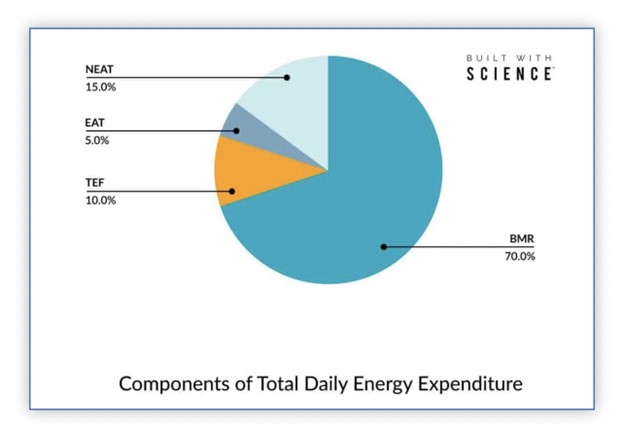In our last blog post, we covered the concept of TDEE, Total Daily Energy Expenditure, or the total number of calories your body burns each day. We focused on
*BMR, Basal Metabolic Rate, and,
*NEAT, Non-Exercise Activity Thermogenesis
You may recall that BMR and NEAT make up the biggest percentages of your daily calorie burn.

In this post, we’re going to focus on the two other important components of TDEE that often get overlooked: Exercise Activity Thermogenesis (EAT) and Thermic Effect of Food (TEF). Understanding these two factors can help you maximize your results and make better decisions about your fitness and nutrition.
While BMR and NEAT are crucial, EAT and TEF are two additional factors you can control directly to influence your TDEE.
What is EAT (Exercise Activity Thermogenesis)?
EAT refers to the calories you burn through structured exercise. This includes our Semi-Private Strength Training and our Circuit Training sessions! Other examples include running, cycling, swimming, or any workout you do intentionally. While EAT typically makes up a much smaller portion of TDEE compared to BMR, it is a powerful tool for shaping your body composition and overall fitness.
Why EAT Matters:
- Direct Calorie Burn: Exercise is one of the most efficient ways to burn calories and help create a calorie deficit if weight loss is your goal.
- Increased Metabolic Rate: Regular exercise, especially strength training, can increase your muscle mass, which in turn boosts your BMR.
- Mental and Physical Benefits: Beyond the calorie burn, regular exercise reduces stress, improves sleep, and boosts mood.
What is TEF (Thermic Effect of Food)?
TEF is the energy your body uses to digest, absorb, and metabolize the food you eat. Every time you eat, your body burns calories to process the nutrients. On average, TEF accounts for about 10% of your TDEE. However, different types of food require different amounts of energy to digest.
Here’s a quick breakdown:
- Protein has the highest TEF, requiring 20-30% of its calories to digest.
- Carbohydrates have a moderate TEF, using 5-10% of their calories for digestion.
- Fats have the lowest TEF, using 0-5% of their calories.
Why TEF Matters:
- Boost in Caloric Burn: Simply by choosing more protein-rich foods, you can naturally burn more calories throughout the day. This is one reason why protein-forward diets are often recommended for weight management.
- Improved Satiety: Foods with higher TEF, particularly protein, tend to make you feel fuller longer, reducing the likelihood of overeating.
- Metabolic Efficiency: Maximizing TEF through diet choices can make your metabolism more efficient and support your fitness goals.
Practical Ways to Boost EAT and TEF
Now that you understand how EAT and TEF contribute to your TDEE, let’s talk about how you can enhance them.
For EAT:
- Add Regular Strength Training like our Semi-Private Strength Training: Building muscle increases your BMR and the calories you burn even when at rest.
- Incorporate High-Intensity Interval Training (HIIT) like our Large Group Circuit Training: HIIT workouts are great for maximizing calorie burn in a shorter amount of time.
- Consistency is Key: Even moderate-intensity exercise, when done consistently, will boost your EAT and TDEE.
For TEF:
- Prioritize Protein: Aim to include a source of protein with every meal. Eggs, lean meats, fish, beans, tofu, cottage cheese, and Greek yogurt are great options.
- Eat Whole Foods: Whole grains, vegetables, and fruits require more energy to digest compared to processed foods.
Conclusion: Small Changes, Big Impact
EAT and TEF may seem like small components of your TDEE, but they can have a significant impact on your energy balance and fitness goals. By incorporating regular exercise and making smarter food choices, you can optimize these factors and take control of your body’s energy expenditure.
Every workout and meal is an opportunity to boost your TDEE and move closer to your health and fitness goals!
~ Coach MJ

